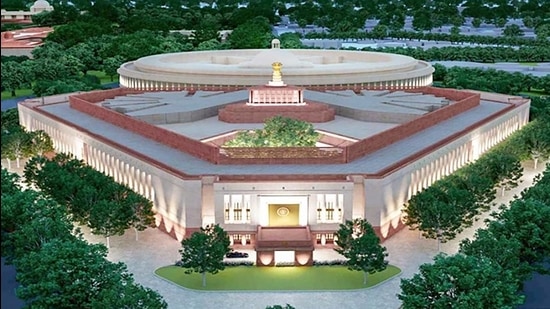Parliament: New chambers to provide better ‘line of sight’ for MPs
In the existing Lok Sabha chamber, key sections of the treasury bench and the Opposition rows face each other but the table of the secretariat, that is placed between them, blocks the view from both sides
The Lok Sabha and Rajya Sabha chambers in the new Parliament building will be designed not just to accommodate more lawmakers and additional comfort, but also provide a better “line of sight” for them.

In the existing Lok Sabha chamber, the key sections of the treasury bench and the Opposition rows—where the top leaders of each side sit—face each other but the table of the secretariat, that is placed between them, blocks the view from both sides. The secretariat’s table is an integral part of the chamber. It’s where the secretary general, other senior officials and the Parliamentary reporters sit to assist the Speaker.
According to Bimal Patel, the chief architect tasked to design the building complex, the seating arrangement for MPs would be such that each parliamentarian would get 60cm by 60cm space to sit on the new benches under the new arrangement. The MPs will sit comfortably in broad two-seater benches, accessible from either side so that no one will have to squeeze through — and which can, when a joint session is held, accommodate three persons, HT had reported in January. Patel had also pointed desks will be arranged for all MPs to be accommodated as opposed to the current setting where desks are limited only for the first few rows. For joint sessions the desks will accommodate three MPs instead of two.
In the new,horseshoe-shaped chambers, the secretariat’s table will be again placed between the two sides but 1.5 feet lower than the current height. “This has been planned to give an uninterrupted view of the treasury bench and the Opposition bench,” said an official.
Also Read: Hardeep Puri Interview: On Central Vista, Adani airports row, vaccine exports
If it’s done, Prime Minister Narendra Modi, home minister Amit Shah, defence minister Rajnath Singh and other top government leaders as well as Opposition leaders such as Sonia Gandhi or Mulayam Singh Yadav or Adhir Chowdhury can have a full view of the Lok Sabha.
This was discussed and approved during a recent briefing meeting with Speaker Om Birla. Central Public Works Department (CPWD) and Parliament officials were present at the meeting to discuss the plans.
Another proposal of CPWD, to put some barriers along the front row that would effectively stop Opposition MPs from rushing into the Well of the House, was promptly rejected by Birla.
According to officials present in the meeting, “Birla said such things (barriers) don’t go with the democratic spirit of Lok Sabha. The Opposition will do its job and the government will do its work.”
Both the Lok Sabha and the Rajya Sabha chambers will be spacious with lobbies to accommodate a larger number of MPs, keeping in mind the current delimitation of Parliament seats will end in 2026 and any new arrangement as per the 1991 census might see more MPs in the House.
The proposed new Parliament building will have a seating capacity for 888 members in the Lok Sabha chamber, with an option to increase it to 1,224 members during joint sessions. Similarly, the Rajya Sabha chamber would have a seating capacity for 384 members, according to its latest plan.
The proposed building, spread over four floors, will also use motifs and murals of India’s national flower lotus and national bird peacock for a dash of distinctive identity. A banyan tree—the country’s national tree—will be planted at a prominent place inside the new complex, officials involved in the planning said on Friday.
India’s national emblem will also sit atop the new Parliament building, HT had reported on September 16, 2020. Work on the new Parliament building began on Friday and is scheduled to be completed by next year. The building will by Tata Projects Ltd. at cost of ₹971 crore and would have a built-up area of 64,500 square metres.
The existing circular building, completed in 1927, is most famous for its 144 columns but it too has some recognisable Indian touches. The use of fountains both inside and outside the building, desi-style balconies and different forms of marble ‘jali’ bear symbols of Indian heritage.
The new building, to be constructed right in front of the existing one, will use the motifs or visual reliefs in a more contemporary way, as per the plan. These symbols of India’s national bird, flower and tree are also expected to contribute to the visuals of the new-era building.
“One House will have lotus motifs while the other House will see peacock-inspired relief. There will be no Central Hall, but a central lounge will be available for MPs to socialise in,” said an official.
The central foyer has been renamed the Constitution Hall as it is expected to display the Constitution for public viewing. A library will also come up near the central foyer. It will have sculptures of parliamentarians and images representing the diversity of India. At one side of the Constitution Hall will be the Constitution gallery, where the Constitution will be displayed.
The triangular complex is also designed to include 120 offices with six separate entrances for member of the public, MPs and VIPs, including the Speaker and the vice-president.
The current plan, according to Patel, comprises “the Lok Sabha, Rajya Sabha and an open-to-sky courtyard around which there would be a lounge and in the middle there will be a foyer.”
CPWD will also build an office complex for MPs in place of the Shram Shakti Bhawan that would connect the Parliament complex through an underground pathway.





